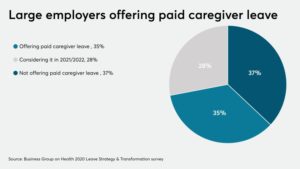The number of employees shouldering caregiver responsibilities has been rising, even before the outbreak of the coronavirus pandemic, according to a survey by Northeast Business Group on Health. Now, more than ever, employers need to be prioritizing benefits to fit the needs of these employees.
“The challenges for employee-caregivers have increased exponentially as a result of COVID-19,” says Candice Sherman, CEO of NEBGH. “Employers are trying to increase support by providing more back-up help, flexible working hours and access to expert resources, and some are providing relief funds to help with expenses.”
Since the start of the pandemic, companies have been bolstering their caregiving and childcare benefits in an effort to better support their employees. Microsoft has provided employee parents 12 weeks of paid time off in order to help them deal with the school closures that have resulted from the COVID-19 pandemic. Insurance company TIAA has increased its existing backup care benefit to $100 from $65 per day, per dependent.
The majority of employees are balancing the responsibilities of work and home, as both caregivers and working parents. Roughly one in six employees provides care for an ill or elderly family member, according to statistics from the Family Caregiver Alliance. Among married-couple families with children, 96.8% had at least one employed parent, and 61.1% had both parents employed, according to the Bureau of Labor Statistics.
Employees who act as caregivers for loved ones can face numerous challenges, including stress and anxiety, loneliness, higher incidences of certain medical conditions, and financial strain. These stressors can have a direct impact on a person’s work performance, whether working from home or in the office, due to absenteeism, reduced engagement and productivity, and higher health care costs.
“Employers should consider the financial, logistical and emotional burden that [caregiving] places on [employees],” says Shadiah Sigala, CEO of Kinside.
Employers are dedicated to providing relief for their caregiving employees, according to the NEGBH survey. More than three quarter of respondents (79%) believe caregiving will be an increasingly important issue over the next five years. A majority of the employers (61%) said caregiving is a top priority for them, but 22% see themselves as below or well below average in offering these benefits when compared to their peers.
Employers are also aware of the importance of caregiver benefits on their employee culture. Eighty-four percent believe that having a caregiving-friendly workplace is important for retaining and attracting talent, a 9% increase from 2017, according to the survey. An increasing number of employers are providing paid leave specifically for caregiving – the percentage of those not doing so fell from 89% to 77%. Increasing leave for caregiving and implementing flexible work arrangements were at the top of benefit managers’ caregiving wish lists.
While the strain of caregiving and childcare has been a challenge during coronavirus, employers will need to consider how their benefits will affect employees when returning to their normal routines. When it comes to child care, about 20% of daycares will not reopen their doors after the pandemic subsides, according to data collected by Kinside, a child care benefit provider.
“As the CEO of your company, you should expect a second crisis created by the dearth of daycare supply, as well as the lack of infrastructure required to get your workforce back up and running,” Sigala says. “COVID-19 has exposed a secret that the modern work world has tried to keep under wraps for decades: childcare is not a luxury. It’s an essential need and for hundreds of thousands of workers in the U.S., it’s a need unmet.”
Creating benefits that support employees at all stages of life, no matter the circumstance, has been a priority for employers over the last several years. However, the COVID-19 crisis is highlighting the role of benefits to tackle these demands. Employees will increasingly look to employers for support and guidance, and employers will need to step up.
“When restrictions are lifted, a new world will emerge that more closely resembles the pre-COVID-19 one,” Sigala says. “But employees’ childcare troubles won’t be solved then. Employers should be prepared to help parent workers find new care or suffer ongoing productivity losses.”


